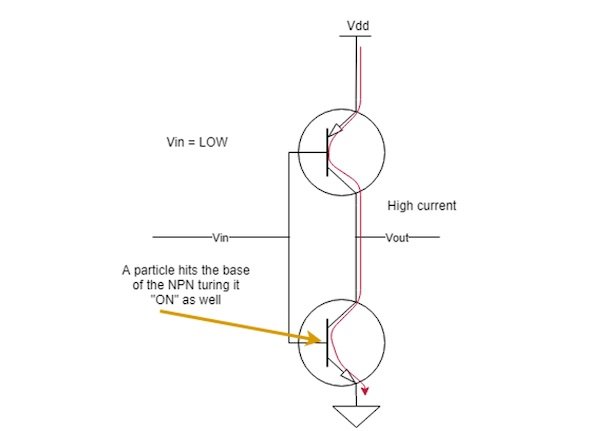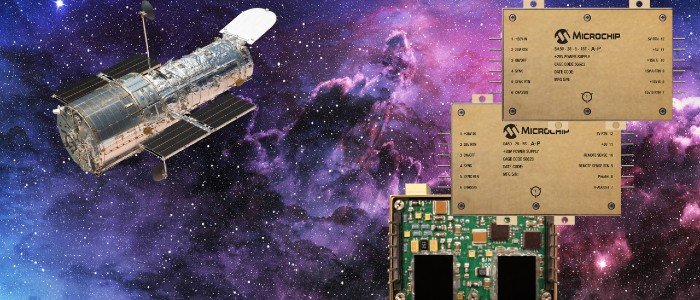Designing space technology can be costly, complex, and risky. Often space technology gets one chance to succeed or fail, and that's when it's being launched into space.
One recent space venture that felt the struggle space technology brings is SpaceX.
Recently, SpaceX reported the loss of up to 40 out of 49 Starlink satellites that it launched on February 3, 2022, to the Low Earth Orbit.
They announced that most of those lost satellites were impacted by a geomagnetic storm created by disturbances between the Earth's magnetic field and charged particles from the sun.

A high-level overview of components that radiation and magnetics from space can affect. Screenshot used courtesy of NASA
The storm caused high atmospheric drag, which led to the failure of some onboard systems. The 40 deorbited satellites will enter or have already entered the Earth's atmosphere to ensure a sustainable space environment.
This event further presses the importance of space system designers selecting highly reliable space-grade components for control systems in a satellite.
However, electronic devices face various unpredictable challenges while in space, ranging from extreme temperatures to high amounts of space radiation. Moreover, satellites are beyond repair in case of failure.
Therefore, there is always a demand for robust electronic components with high Mean Time to Failure (MTTF), a metric related to the reliability or average lifespan of a component.
With this in mind, this article will look at some of the challenges electronic circuits face in space and then dive into three recent ventures targeting the radiation-hardened (rad-hard) and space industry.
Challenges for Electronic Circuits in Space
When designing electronics heading into the "final frontier," there are many things to consider.
The first hurdle that electronic devices have to withstand is the vibration and noise generated during the vehicle's launch. These sudden vibrations can damage and even short electrical devices; therefore, space-grade electronics must pass various vibration and shock absorptions tests.
Another challenge is the high electrostatic discharge due to photoelectric effects and low-density plasma around the satellite. Electrical components must withstand discharges as high as 20,000 V in space environments. To prevent this, materials that resist the build-up of charges are preferred as covering.
Apart from these issues, space-grade electronics face a massive thermal management challenge. Electronics are exposed to extreme temperature fluctuations in space, and ceramic packages provide high protection against these harsh environments.
However, the problem is the heat dissipation generated by electronics as no thermal conduction occurs in a vacuum. The life expectancy of components can severely degrade as they are exposed to high temperatures.
When it comes to the reliability of components in space, the largest hurdle is radiation.
In space, electronic devices are vulnerable to various ionized and uncharged particles such as Alpha and Beta particles, photons, X-rays, and Gamma rays.

An example circuit showing the effect a particle can have on a circuit. Image used courtesy of Altium
These particles may hit electronic components and create unwanted behaviors classified as total ionizing dose (TID) and single event effects (SEEs). TID is a long-term failure related to MTTF.
The effects leading to TID are generally associated with charge accumulation in semiconductor devices. The charge accumulation can cause leakage currents, degradation of gain, undesirable input-output characteristics, and more severe permanent issues.
On the other hand, SEEs are caused by a high-energy particle passing through a device, injecting a charge. These effects can cause bit flips, a state change in memory, and many permanent issues like damage to gate oxide, latch-up, etc.
As we can observe, there are plenty of unpredictable challenges electronic devices face in space. Moreover, instruments in satellites are getting more complex as modern satellites employ high-speed communication circuits and other onboard processing units. Therefore, there is a demand for space-grade components that simplifies system development.
Microchip's Hybrid Space Power Converters
With all of those challenges in mind for designing space electronics, a recent release from Microchip hopes to keep the ball rolling for new space-rated converters.
Recently, Microchip released a family of 50 W hybrid space-grade power converters, SA50, with standard outputs of 3.3 V, 5 V, 12 V, 15 V, and 28 V in single and triple output configurations. The devices aim to simplify system development on space applications.
Space systems designers have no flexibility in terms of power converters to incorporate circuits with non-standard input voltages. Thus, Microchip's flexible converters help to allow designers to meet the specific voltage and current demands and simplify their system.

Microchip's family of space-rated converters. Image used courtesy of Microchip
All in all, the SA50 converters are electromagnetic interference (EMI) compliant and rad-hard. These converters specify an MTTF of 8 million hours and 87% efficiency, which is claimed to be the highest of any hybrid space-grade DC-DC converter.
BAE System Gets Contract for Rad-hard Microelectronics
Since space is becoming a larger part of the electronics industry, with satellites and communication hardware, there is a need for more space-rated components.
Recently, BAE Systems has been awarded a $60 million contract from Army Contracting Command, Rock Island, to develop space-grade microelectronics with Intel's commercial foundry, Intel Foundry Services.
Currently, the commercially available state-of-the-art ASICs (Application Specific Integrated Circuits) and other integrated circuits are not space-grade. Therefore, BAE Systems' FAST labs and Intel aim to expand available electronics technology for space applications. Together they are building a new design library to pave the road for advanced space-grade microelectronics.
In addition to Intel Foundry Services, BAE Systems collaborates with a team composed of Cadence Design Systems, Carnegie Mellon University, Movellus, Reliable MicroSystems, and Sandia National Laboratories.
With so many companies starting to get involved and work on creating space-rated ICs, the momentum is starting to ramp up for future components.
Collaboration to Develop Space-grade FPGAs
BAE Systems and Intel aren't the only ones hoping to jump into the space electronics design arena.
CAES and Lattice Semiconductor recently announced their collaboration to release space-grade Lattice FPGAs.
The developed Certus-NX-RT and CertusPro-NX-RT FPGAs are compact and power-efficient. They are based on a 28 nm process technology and feature temperature-resistant tin-lead (SnPb) terminations using a radiation-tolerant, fully-depleted silicon-on-insulator (FD-SOI) manufacturing process.

A diagram outline some of the benefits Lattice and CAES bring to this collaboration. Image used courtesy of CAES
The collaboration will address the growing demand for low-power programmable space-grade programming units. Esam Elashmawi, Chief Strategy and Marketing Officer, Lattice Semiconductor, believes that with Lattice's FPGA technology and CAES' aerospace knowledge, they could accelerate the processing needs for space applications.
The Push for More Rad-hard and Space-rated Components
Designing space systems that last for decades is a challenging task, and as the semiconductor devices and complexity are increasing, the task of radiation hardening is also becoming more complex.
The feature size of devices continues to shrink, making them more vulnerable to radiation effects. Moreover, there is always a trade-off between performance and reliability, and it is a challenge that space-grade components suppliers are trying to overcome.
However, with various radiation-hardened devices emerging from many companies and institutions, the lack of space-grade state-of-the-art electronic devices is being addressed slowly.
